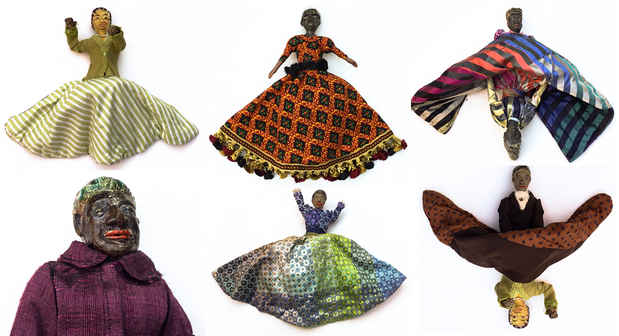Sana Musasama “I Never Played with Dolls”
TSA

This event has ended.
Curated by Rachael Gorchov
Tiger Strikes Asteroid New York presents Sana Musasama: I Never Played with Dolls, the first exhibition featuring her Topsy Turvy dolls, a project Musasama first embarked on over a decade ago to commemorate personally influential women and girls. The work represents a spectrum of individuals from public figures such as Coretta Scott King and Jackie Kennedy to Musasama’s family members and symbolic stand-ins for anonymous child soldiers in Sierra Leone. Throughout its evolution, this body of work has grown to incorporate not only Musasama’s ceramic work, 32 hands have contributed to this project. To list a few: senior citizens in New York City, survivors of human trafficking in Cambodia, and art and engineering students, thus collaborating with communities she has worked with as an activist for 26 years and as a teacher. Accompanying the Topsy Turvey dolls will be Musasama’s “I See Me” dolls, reimaginations of a doll Musasama’s mother made with her when she was a preteen to help her appreciate her own hair when other children perceived wavy, “whiter” hair to be more desirable. The Artist at Play: new works by Sana Musasama, an essay on Musasama’s life and this body of work by TS Murphy accompanies this exhibition.
Popularized during the American Antebellum period, Topsy Turvy dolls frequently portray an African head and torso fused at the waist with a European one. When one side is held upright, a long skirt hides the other. The dolls can be flipped to reveal and hide the reverse. Many theorize that enslaved Black women sewed Topsy Turvy dolls for their children. As Murphy writes:
“It was said, the enslaved children ‘couldn’t have dolls in their image’. If they were ever caught with a ‘black doll’, they would simply ‘turn it over’ to the white more acceptable side. There is a theory about the opposite being true that the children of the enslaved shouldn’t play with white dolls resembling their owners, only black ones.”
Musasama’s pairings of individuals in her Topsy Turvy dolls reveal a constellation of influences and associations. Nina Simone is paired with Winnie Mandela, Rosa Parks with Elizabeth Jennings, Musasama with her mother. Through these dolls, Musasama also commemorates women with whom she and society have complicated relationships with. Condoleezza Rice is joined with Monica Lewinsky, Sally Hemmings with Martha Jefferson.
The Topsy Turvy dolls are raku-fired ceramic, wearing intricate clothing sewn by Musasama’s collaborators. Many are animated, turning in a circle. The dolls are meant to be dynamic, interactive. The mechanics suggest how they might be played with, some seem to come to life.
The I See Me dolls represent a couple of formative influences and the taking charge of one’s own narrative. In addition to referencing a childhood memory, they also mark the beginning of dollmaking in Musasama’s career. Decades ago, she taught teenage girls in alternative-to-incarceration centers. There, she witnessed powerful art therapy exercises in which the students projected themselves onto blank dolls. Through this, she recognized the power of seeing oneself in a doll. Like many of them, Musasama never played with dolls as children, having not seen adequate representations of herself in dolls. While some may see racist tropes in the hairstyles of the dolls, Musasama is adamant that this read is that of an othering eye. They reflect how she and her peers wore their hair as children and their aesthetic.
In this body of work, Sana Musasama has exhumed personal and collective histories and experiences and has woven them with sorts of dollmaking that have become obscure through decades of relegation to play and folk. She has turned these dolls into a platform from which to praise the women and girls represented in them and their makers.
Sana Musasama received her BA from City College of New York in 1973 and her MFA from Alfred University, New York in 1988. She was awarded the 2022 Life Honorary Membership Award and the 2018 Outstanding Achievement Award from the National Council on Education for the Ceramic Arts (NCECA) for her years of teaching and her humanitarian work with victims of sex trafficking in Cambodia and the United States. She was featured in “Artists on Artists to Watch, and Maybe Even Collect,” by Noor Brara in the New York Times T Magazine in 2021. Musasama is the coordinator of the Apron Project, a sustainable entrepreneurial project for girls and young women who reintegrated back into society after being forced into sex trafficking. In 2016, she was a guest speaker on “Activism through Art” at ROCA. A recently published article by Cliff Hocker, “If I can Help Somebody: Sana Musasama’s Art of Healing” appears in the International Review of African American Art. In 2015, the Museum of Art and Design in New York selected four works from The Unspeakable Series for their private collection; Musasama was awarded the ACLU of Michigan Art Prize 7 and Art Prize 8. In 2002, she was awarded Anonymous Was a Woman and in 2001, Musasama was featured in the 2001 Florence Biennial. Her work is in multiple collections such as The Mint Museum in Charlotte, North Carolina; The Museum of Art and Design in New York, New York; the Cooper Hewitt Smithsonian Design Museum in New York, New York; the Hood Museum of Art in Hanover, New Hampshire; The Studio Museum in Harlem, New York; Schomburg Center for Research in Black Culture in Harlem, New York; Bluffton University in Bluffton, Ohio; and in numerous private collections. Sana Musasama lives and works in New York.
Media
Schedule
from September 17, 2022 to October 16, 2022
Opening Reception on 2022-09-18 from 14:00 to 18:00